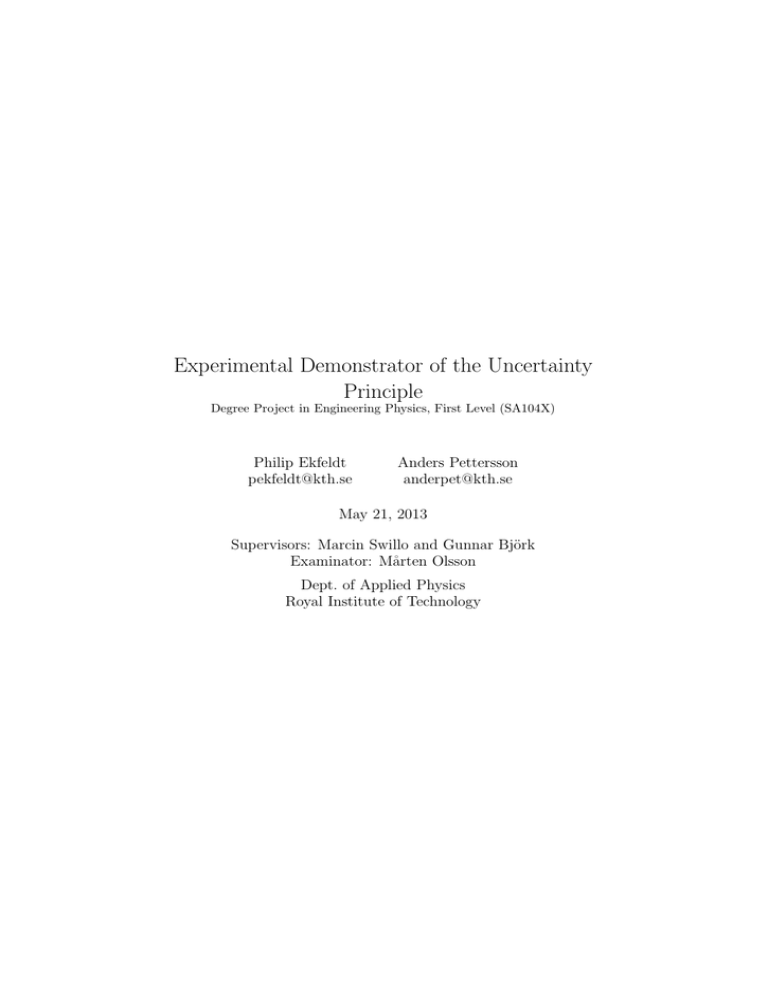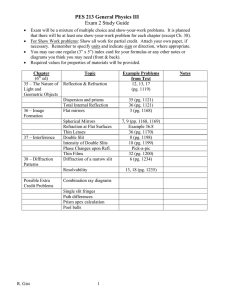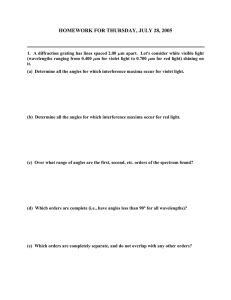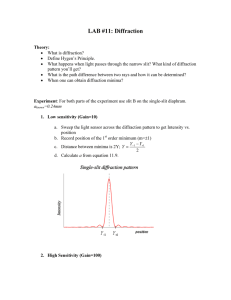
Experimental Demonstrator of the Uncertainty
Principle
Degree Project in Engineering Physics, First Level (SA104X)
Philip Ekfeldt
pekfeldt@kth.se
Anders Pettersson
anderpet@kth.se
May 21, 2013
Supervisors: Marcin Swillo and Gunnar Björk
Examinator: Mårten Olsson
Dept. of Applied Physics
Royal Institute of Technology
Abstract
The goal of this project was to create an intuitive and clear demonstrator
of the defining properties of quantum mechanics using single slit diffraction
of light, which has quantum mechanical properties because of light’s waveparticle duality. In this report we will describe the process and thoughts
behind our project of creating a portable demonstration of the uncertainty
principle. By designing and building both a physical setup with a laser, a
slit, mirrors, lenses, beam-splitters, attenuators and cameras, and developing
software which displays images from the cameras in a clear user interface
with calculations we hope that students from high schools and gymnasiums
that visit Vetenskapens Hus at Alba Nova will learn something new while
using the demonstrator.
CONTENTS
Philip Ekfeldt, Anders Pettersson
Contents
1 Introduction
1.1 Objective . . . . . . . . . . . . . . . . . . . . . . . . . . . . .
2
2
2 Theory
2.1 The Uncertainty Principle . . . . . . . . . . . . . . . . . . . .
2.2 Theoretical Value of Uncertainty . . . . . . . . . . . . . . . .
2.3 Uncertainty of Laser Source . . . . . . . . . . . . . . . . . . .
3
3
3
5
3 Method
3.1 Optical Setup . . . . . . . . . . . . . . . . . . . .
3.1.1 Projecting Images to the Cameras . . . .
3.2 Software . . . . . . . . . . . . . . . . . . . . . . .
3.2.1 Description of the User Environment . . .
3.2.2 Calculating the Standard Deviation of the
3.2.3 Calculating the Standard Deviation of the
4 Results
. . . . . . .
. . . . . . .
. . . . . . .
. . . . . . .
Position . .
Momentum
6
6
8
10
10
11
12
14
5 Discussion
14
5.1 Physical Design . . . . . . . . . . . . . . . . . . . . . . . . . . 14
5.2 Software Design . . . . . . . . . . . . . . . . . . . . . . . . . . 15
5.3 Measured Results . . . . . . . . . . . . . . . . . . . . . . . . . 16
6 Conclusion
17
7 Acknowledgements
17
1
Philip Ekfeldt, Anders Pettersson
1
Introduction
After James Maxwell formulated his equations that combined electricity and
magnetism into a single theory at the end of the 19th century, the general
consensus became that light travelled as an electromagnetic wave. It was
not until Albert Einstein posted his theory on the photoelectric effect that
the idea that light behaves both as a wave and as particles gained momentum again.
Our demonstration is based on photon diffraction, the natural phenomena
that allows photons to diffract in a single slit just like a wave to create a
diffraction pattern. Combining this with the uncertainty principle of quantum mechanics, we can analyse our results and compare it to the inequality
σx σpx ≥ h̄2 derived by Earle Hesse Kennard in 1927 [1]. The basis for this
principle came from the groundbreaking work in quantum mechanics by
German physicist Werner Heisenberg who earlier that same year gave the
argument that such a limit for the deviation in position and momentum
should exist.
1.1
Objective
The primary goal of this project is to create a portable demonstrator of the
uncertainty principle of quantum mechanics, σx σpx ≥ h̄2 , with the help of
single slit diffraction of light. This demonstration is meant for showing high
school students real quantum effects and educating the basic principles of
quantum mechanics, which are visually clear in the diffraction pattern from
the single slit experiment.
To show these effects, the demonstration is divided into two parts. First
we create the optical experiment, with a Helium-Neon laser, a slit, mirrors,
lenses, attenuators and detectors. This setup shows the diffraction pattern
on a white paper. Connected to the detectors we also have a computer
with software capable of displaying the detected images and calculating the
essential properties from these patterns which can then be related to the
uncertainty principle.
The tasks in this project were divided as follows. Philip was in charge of the
optical experiment and writing the theoretical background, while Anders
handled the programming of the software and the measurement analysis. It
should be noted that we have worked together on this project and helped
each other with our different tasks.
2
Philip Ekfeldt, Anders Pettersson
2
2.1
Theory
The Uncertainty Principle
The uncertainty principle of quantum mechanics describes the inherent uncertainties in a particle’s properties such as position and momentum due to
particles’ wave nature. What the principle states is that it is impossible to
know or prepare precisely both a particle’s position x and its momentum
px along the same axis. There is a strict lower limit for the product of the
uncertainties of these two properties: ∆x∆px ≥ h̄2 with h̄ being the reduced
h
Planck constant 2π
= 1.055 · 10−34 Js. In physics, this uncertainty ∆ is
defined as the standard deviation σ, which is the notation we will use in this
report [2].
This uncertainty relation can be seen in a single slit diffraction experiment.
Sending light through a narrow slit, the light is diffracted and a diffraction
pattern is seen on a screen on the other side. Making the slit less wide,
thus reducing the uncertainty of the photons’ position, makes the diffraction
pattern wider indicating an increased uncertainty of their momentum in the
direction of the slit width. We would expect this diffraction to occur due to
the wave nature of light. The interesting thing is this: If you would send each
photon by itself through the slit, it would yield the same result. The photons
hitting the screen would create a diffraction pattern anyway if you would
accumulate their impact positions. This shows that photons (and particles
in general) have an inherent uncertainty in position and momentum.
2.2
Theoretical Value of Uncertainty
The light intensity of the laser used in the project can be seen as having
the form of a Gaussian function. If you open the slit completely so that
none of the light is blocked, we can approximate the intensity function over
the horizontal axis (x) as a Gaussian if we average the intensity value of
the beam over the vertical axis (y). Suppose that this Gaussian intensity
function (which is proportional to the probability distribution of the light)
has a standard deviation of σx . From this follows that
−
I(x) ∝ e
x2
2σx 2
.
Since the complex amplitude of the wave A(x) is proportional to the square
root of the intensity we get:
A(x) ∝
2
p
− x
I(x) ∝ e 4σx 2 .
Theory [3] shows that the far field intensity function can be found by applying the Fourier transform to this complex amplitude function of the source,
3
2.2
Theoretical Value of Uncertainty
Philip Ekfeldt, Anders Pettersson
0
x
, with z being the distance from
with the frequency variable equalling ξ = λz
the source to the measuring point on the z-axis and x0 being the distance
from the z-axis at this point.
A(x) ∝ e
−
x2
4σx 2
F
−→ U (ξ) ∝ e−4σx
2 (πξ)2
→
− I(ξ) ∝ U (ξ)2 ∝ e−8σx
2 (πξ)2
,
where U (ξ) is the complex amplitude of the diffracted wave depending on ξ
and I(ξ) is the related intensity which both also have the form of a Gaussian
function. Comparing this to the original Gaussian function, we can see that
1
ξ has a standard deviation of σξ = 4πσ
.
x
A photon has the linear momentum
p = h̄k,
with k being the wave vector 2π
λ . The momentum along the x-axis, px , for
the diffracted beam can be calculated using
px = p sin θ = h̄
2π
sin θ
λ
with the average being zero, see Figure 1. Since x0 << z for the far field,
x0
≈ sin θ.
z
This means that ξ can be rewritten as
ξ≈
sin θ
h̄
→
− px = 2h̄ξπ →
− σpx =
.
λ
2σx
As mentioned in section 2.1 we are only interested in the deviation of the
momentum along the same axis as the deviation of the position, which is
along the x-axis. Using the values for the standard deviations in the uncertainty inequality σx σpx ≥ h̄2 we find that this result represents the equality.
This means that using a Gaussian beam one saturates the uncertainty inequality.
If we instead close the slit, the intensity function at the slit looks more like
a rectangular function. This would return a diffraction pattern on the form
of a sinc function squared,
sin πwξ 2
I ∝ sinc2 (wξ) =
πwξ
by Fourier transforming, where w is the width of the slit. Calculating the
standard deviation of the normalised I(ξ) one will find that the integral does
not converge. This is because ξ is not limited and
sin πwξ 2 2
ξ ∝ sin2 πwξ
πwξ
4
2.3
Uncertainty of Laser Source
Philip Ekfeldt, Anders Pettersson
Figure 1: Single slit wave diffraction
in the integral does not converge when ξ goes toward infinity. What you
need to do is look at the angular distribution of the intensity (since θ is
limited between − π2 ≤ θ ≤ π2 ), which you can get by integrating the complex
amplitude of the light over the slit width.
2.3
Uncertainty of Laser Source
In an ideal case the beams from a light source would be parallel, but in reality, due to the uncertainty principle, any finite source has a divergence. The
specification of the laser has two interesting parameters for the uncertainty;
beam diameter ( e12 ) of 0.65 mm and beam divergence ( e12 ) of 1.24 mrad.
The beam radius (0.325 mm) r0 is half of the beam diameter and the beam
divergence in one direction (0.62 mrad) from the z-axis is half of the stated
beam divergence. The description ( e12 ) means that where the absolute value
of x (or r in the two dimensional case) equals the beam radius, the intensity
of the beam is e−2 times the maximum value which occurs at the center of
the beam. Remember that a2 Gaussian function with a standard deviation
of σx is proportional to e
−
x
2σx 2
. We can use this to derive σx :
2
r0
2
2σx
2
0.3252 mm
e =e
→
− 2=
→
− σx = 0.1625 mm
2σx 2
We can find σpx in the same way by looking at the beam divergence. First
we can derive σθ in the same way as above, which yields σθ = 0.31 mrad. In
a similar manner as in the previous section we can find σpx by approximating θ ≈ sin θ →
− σθ ≈ σsin θ . The deviation in momentum σpx =
2π
σθ p = σθ h̄ λ = 3078h̄. Multiplying this by σx we get the uncertainty
value σx σpx = 0.50018h̄ ≈ 0.5h̄, which is the best result the laser can have.
This value can be compared to our measured value σpx = 3300h̄ for a fully
opened slit that is reported in the Results section below.
−2
−
5
Philip Ekfeldt, Anders Pettersson
3
Method
Our demonstrator consists of two parts. An optical setup which consists of
the laser and optical components and will provide the results, and a software
that will do calculations and display clear images of the diffraction pattern
and the slit.
Figure 2: Photograph of the optical setup.
3.1
Optical Setup
The optical setup of our demonstration consists of a Helium-Neon laser with
a wavelength of 632.8 nm, an adjustable slit, two lenses with focal lengths
of 15.3 mm and 200 mm, several mirrors and beam splitters to direct the
light, and two CMOS-cameras. These are all placed and mounted onto a
portable optical board, see Figure 2. The purpose of this setup is to diffract
the light beam from the laser and direct the light to the two cameras. One
camera will show the near field image of the slit (with next to no diffraction)
to provide a clear representation of the slit width while the other camera
will display the diffraction pattern. We also have the pattern displayed on a
white paper/board. To see a general schematic of how the different objects
are placed, see Figure 3. For distances and more specific details, see the
next section. Here is a list of the different objects in the demonstration:
6
3.1
Optical Setup
Philip Ekfeldt, Anders Pettersson
Helium-Neon Laser
A laser that emits a TEM00 mode of light of wavelength λ = 632.8
nm. Has a beam diameter of 0.65 mm ( e12 ) and a beam divergence of
1.24 mm ( e12 ).
Adjustable slit
A slit whose width can be adjusted. Used range (affected by size of
light source) = 0 − 1000 µm.
Beam splitters
Objects of glass that reflect parts of the light and transmits the rest to
divide the beam into two. 1%−10% reflection at 45◦ angle of incidence
depending on the polarization of the incoming light.
Mirrors
Reflects light.
Attenuators
Reduces the intensity of the beam by factors 102 or 104 so the cameras
are not saturated, see Figure 3.
Biconvex lenses
Focuses the light as wanted.
CMOS-Cameras
Captures images. 1280 × 1024 pixels, 6.66 mm × 5.32 mm.
Figure 3: Schematic over the optical setup.
7
3.1
Optical Setup
3.1.1
Philip Ekfeldt, Anders Pettersson
Projecting Images to the Cameras
As mentioned above the demonstration includes two cameras. The two
cameras display two different images; one displays an image of the slit, while
the other displays an image of the far field diffraction pattern. To project
the slit image to the first camera we used a small lens with a focal length
f = 15.3 mm to magnify the image. Due to the difficulty in measuring the
distance between the slit and the lens we first placed those two and adjusted
the camera until the image was in focus. The distance between the source
(slit) and lens, S1 and the distance between the lens and the image (camera)
S2 have to satisfy the formula for thin lenses:
1
1
1
+
= ,
S1 S2
f
with the magnification being S2 /S1 . When the slit is very narrow it is
possible to notice some diffraction in the image of the slit. This is due to
light at high diffraction angles that does not go through the lens since it is
small, 9.24 mm in diameter, which means that some spatial harmonics of
the slit image are missing. This occurs less when the slit is wider since the
light is less diffracted. The schematic for this can be seen in Figure 4.
Figure 4: Schematic over the light travelling to the near field camera. Does
not include beam splitters, mirrors or attenuators.
Even though the exact values for S1 and S2 are not known the approximate
magnification can be derived by looking at the width in pixels on the image,
the pixel width specification of the camera and the slit width that can be
read from the control on the slit. The error in this method comes from the
slit control, which from testing and comparing to the image does not seem
to be increasing the width linearly as it should be. The difference is small
though. More on this in the Software section.
The second camera will display an image of the diffraction pattern. The
diffraction phenomena is called far field diffraction or Fraunhofer diffraction
8
3.1
Optical Setup
Philip Ekfeldt, Anders Pettersson
(after German physicist Joseph von Fraunhofer) if the beams from the slit
to the screen (in this case the camera) can be seen as parallel [4]. In the
setup there is a lens to help projecting the image since Fraunhofer diffraction also occurs in the focal plane of a biconvex lens, see figure 5. We place
the slit approximately at the focal point of a lens with a focal length of 200
mm. As one can see in figure 5, this ensures that the beams will be parallel
if diffraction occur. If the slit is wide and the beams are parallel from the
start (ideal case), they will project an image at the focal point of the lens
where the camera is placed to emulate a far field (since there is next to no
diffraction and the angle is zero). Since the distance between the slit and
the lens is so much greater than the deviation x0 for the diffracted beams
the beams can be seen as parallel and our pattern can be seen as far field
diffraction. This also means that we can approximate the deviation angle θ
0
with θ ≈ sin θ ≈ tan θ = xd where d = f is the distance between the slit and
the lens.
Figure 5: Projection of the far field diffraction pattern.
9
3.2
Software
3.2
Philip Ekfeldt, Anders Pettersson
Software
A large part of the project was the development of the software to acquire
the data from the images provided by the cameras and displaying this data
in a simple way for the user. This was done with the help of the programming language LabView, because it is very useful for image processing and
user friendly. LabView is a graphical programming language that works
with icons that act as functions with different input and output and carries
out specified operations. For more information we recommend the National
Instrument’s webpage [5]. This section provides an explanation of the user
environment and then goes into more detail on how the calculations of the
targeted values were done from the provided images.
Figure 6: Image of the user environment.
3.2.1
Description of the User Environment
Figure 6 shows what the user sees on the screen while running the program.
On the left side the image of the near field camera is shown and below it
is a plot of the light intensity in that image, this will be described in more
detail under the section Calculating the Standard Deviation of the Position.
Above the image is the calculated value for the standard deviation of the
position, σx . To the left is the ”Stop”-button, that stops the program, and
the ”Options”-button that shows or hides several control functions, such
as the ability to change the wavelength λ used in the calculations, moving
the region for measuring the light intensity in the near field image and an
10
3.2
Software
Philip Ekfeldt, Anders Pettersson
indicator of the measured slit size, given in µm. On the right side is the far
field camera image with the related intensity plot, which is explained in the
section Calculating the Standard Deviation of the Momentum and above it
is the value of the standard deviation of the momentum, σpx . At the top is
the product σx · σpx , which is the Heisenberg uncertainty and this value is
compared to h̄2 .
Figure 7: Acquired image of the slit with the defined region of interest. The
rings in the image are caused by dust on the camera and other components
in the setup.
3.2.2
Calculating the Standard Deviation of the Position
In the near-field camera an image of the slit with characteristic sharp edges is
shown, see Figure 7. We wish to measure the amount of light passing through
the slit and use this information to determine the width of the slit and also
the uncertainty of the light’s position, which is described by the standard
deviation. This is done by measuring the intensity in a rectangular region of
interest, characterised by the red lines, along horizontal pixel lines and then
added and averaged vertically, which gives sharp edges. By determining the
distance between the sharp edges we can translate this to the width of the
slit and compare it with the value of the slits own meter. The proportional
constant was determined by testing a large value, 700 µm, for the slit width,
adjusted with the manual slit size control, and comparing it to the slit width
in pixels on the image, a large value was chosen to minimize the error. To
determine the standard deviation Equation (1) was used.
qX
σx =
w(xi )(xi − x0 )2 , and
(1)
11
3.2
Software
Philip Ekfeldt, Anders Pettersson
I(xi )
w(xi ) = P
I(xi )
(2)
where xi represents each pixel in the area of interest, w(xi ) is the probability
weight function and x0 is the average position of the light calculated with
the help of Equation (3).
x0 =
3.2.3
X
w(xi )xi .
(3)
Calculating the Standard Deviation of the Momentum
Figure 8: Acquired image of the diffraction pattern with the defined region
of interest.
The second detector provides an image of the diffraction pattern, Figure 8
and this is used to measure the uncertainty of the momentum. By studying
the image a value of the standard deviation of the momentum is acquired
through a very similar method as for the near-field. The program finds the
image of the diffraction pattern by scanning the image for high intensities
and creates a region of interest around it and calculates the intensity the
same way as before. Figure 9 displays the average intensity in the region
of interest and in it the diffraction pattern is clearly visible even though it
might not be in the direct image of the diffraction pattern. In the image the
y-axis is in logaritmic scale so that the high orders would be easier to spot,
but it gives the impression that their intensity is much higher compared to
the 0:th order than it actually is. From the average intensity the standard
deviation can be derived, but on the original image the light has a position
in pixels and to change the position unit from pixels to micrometers the
position value was multiplied by the pixel size of 5.2 µm. This translates
into the momentum of the light, along the same axis as the position, by
using Equation (4), where λ is the wavelength of the light from the laser
and θ is the diffraction angle.
12
3.2
Software
Philip Ekfeldt, Anders Pettersson
Figure 9: Average intensity graph for the diffraction image.
2πh̄
sin θi .
(4)
λ
For the same reasons as in the example with the Gaussian wave we know
0
that the angles present are very small and that sin θ ≈ xd , where x0 is the
same as the example and d is the distance between the far field lens and the
slit. Equation (5) gives us the average momentum of the light, p0 and this is
then used in Equation (6) to get the standard deviation of the momentum
in the far field, σpx .
pi =
p0 =
σpx =
qX
X
wp (x0i )pi ,
wp (pi )(pi − p0 )2 , and
I(pi )
wp (pi ) = P
.
I(pi )
13
(5)
(6)
(7)
Philip Ekfeldt, Anders Pettersson
4
Results
The software provides us with four measurable parameters, the slit size, the
standard deviation in the position and the momentum and their product.
To test the demonstration we measured these parameters for different slit
sizes to see if the behaviour of the measured values corresponds to theory.
The results are displayed in Table 1.
Table 1: Measurements of σx , σpx and the Heisenberg Uncertainty.
Slit size [µm] σx [µm]
σpx h̄−1 [Ns]
σx · σpx h̄−1 [Js]
Fully opened 214
3300
0.71
900
195
4100
0.80
800
183
4700
0.86
700
167
5200
0.87
600
150
6200
0.93
500
129
8200
1.06
400
106
11600
1.23
300
79
16500
1.30
200
54
24600
1.32
100
24
39200
0.94
The results will be discussed under section 5.3 and an explanation of the
odd value for the smallest slit size will be given there.
5
Discussion
Under this section we will discuss and motivate our choices during the process of making this demonstration, starting with the design of the demonstration, both of the physical design and the design of the software. Subsequently we discuss and try to draw conclusions from the acquired results.
5.1
Physical Design
Setting up and creating the demonstration took a lot of time and work since
everything needed to be aligned and much thought went into the design of
the setup. Since the objective was to show quantum mechanical effects for
high school students, the focus of the design was making it clear, understandable and interesting, but also easy to operate. For example: In the beginning
we thought only one camera was sufficient for making the demonstration,
but after some consideration and for reasons such as less user interactions,
the setup was changed to use two cameras instead. This change made it
easier to display all the information and thereby it is probably easier for
the students to understand and study this phenomenon. At the start the
14
5.2
Software Design
Philip Ekfeldt, Anders Pettersson
intensity of the light from the laser was too strong. This problem was solved
with the help of attenuators and by trial and error the appropriate value for
the attenuators was found. Accidentally we also found out that a rotation
of the laser, in the axis direction of the light, the intensity of the light could
be changed, probably because of the polarization of the light, which affects
the amount of reflected light in the beam splitters.
The sensitivity in the alignment of the components made it important to
make sure that everything was secured properly, since the setup is supposed
to be portable. While detaching the portable optical board from the table
we found that the alignment was disturbed by a small amount, but the images were still centred on the cameras.
Because of the sensitivity of the components it was of great importance that
the demonstration required minimal manual handling from the user. In the
current form, the only thing that needs to be touched by the user (excluding
the computer) is the control for the slit width.
5.2
Software Design
In the design of the software the three focus points, clear, understandable
and interesting, become very apparent. Important figures and values, such
as σx , σp and their product, are centred and large. Only relevant information is displayed and in the standard view no user input is available, all
to make it clear and easy to understand. Other interesting, but less important, information and useful controls are hidden under ”Options”. To
make it easier for the demonstrator, an automatic definer of the region of
interest and also an automatic adjuster of the gain for the far field camera
were implemented. This will give the demonstrator free hands to focus on
explaining the problem and phenomenon showed on the screen.
The way of calculating the standard deviation in both position and momentum, averaging over several horizontal lines in a region of interest, instead
of for example only choosing one line, was preferred since then all the light
could be studied, which gives a more correct image of the distribution of the
light, and also the error in for example measuring the slit size gets smaller.
On the other hand all these calculations causes a decrease in performance
speed, but this was not very noticeable and thereby acceptable.
For the slit we needed to compensate for the background noise, because even
though the dark pixels in the image (those outside the slit image) had a very
small intensity, their impact on the standard deviation of the lights position
seemed significant. Since we knew that in reality these areas outside of the
slit should have been dark we could neglect them by considering values un15
5.3
Measured Results
Philip Ekfeldt, Anders Pettersson
der a specific value as background noise. These dark pixels probably had a
large impact since they were many of them and that the distance from the
intensity middle point x0 was long, which gave a high value to the (xi − x0 )2
term in Equation (1).
Since the intensity of the light in the diffraction image is dependent on the
slit size, a program for automatically adjusting the gain, light intensity amplifier, of the camera was implemented, but since this also increases the
background noise, a way of neglecting the background noise was tried. This
was done by finding the minimum average intensity and multiplying it by
1.5 and then subtract it from the whole intensity vector and all negative
values were set to 0. To keep the gain low, so that the amplification of the
noise were kept at a minimum another way of adjusting the intensity was
implemented, automatic change of the exposure time of the camera. This
would have been preferable to be used as the only changing factor of the
intensity, but since small changes in the exposure time for some unknown
reason caused huge changes in the intensity, this was not possible. This way
of handling the noise seems to give reasonable values and nice intensity plots
such as the one in Figure 9 where the diffraction pattern is easy to see in a
lin-log plot even though it is difficult to see by eye in the original image of
the diffraction pattern.
5.3
Measured Results
In the results we could clearly see that the product, which is to be compared
with the Heisenberg limit, was increasing with decreasing slit sizes and that
we got the lowest value for the fully opened slit, which was expected because
when the slit is fully opened the laser’s light intensity distribution looks
almost like a Gaussian wave which should then provide a result with the
product exactly equal to h̄2 which was shown under the Theory section.
There are several reason why we do not get such a results, for example the
light distribution in not a perfect Gaussian, aberrations from the lenses and
other imperfections with the setup. The product increase with decreasing slit
sizes because the slit disrupts the light’s path, which gives us the diffraction
pattern, and this causes a decrease in the standard deviation in the position,
because the light gets more focused and starts looking like a sinc-function
rather than a Gaussian, but also a large increase of the standard deviation
of the momentum, because of the higher orders of diffraction. For the last
measurement with the slit size around 100 µm the diffraction pattern was
so spread out that only the 0:th order and half of the 1:st order actually
hit the camera which could explain the unexpected value acquired for that
measurement.
16
Philip Ekfeldt, Anders Pettersson
6
Conclusion
During this project, we found that the task which consumed the most time
by far was the software programming and more specifically, finding a good
way to auto-adjust the intensity of the pattern.
In our results we find no reason to believe that the Heisenberg uncertainty
principle should be untrue, instead we find a strong coherence with theory and another implication that the principle holds. Since our results are
close to the theoretical result given by the example of the Gaussian wave, we
feel assured that our methods of calculation are correct and our results solid.
We believe and hope that our demonstration will be able to educate young
students that visit Vetenskapens Hus, interest them in an otherwise, for
most people, spooky and distant theory as quantum mechanics and that
this is done in a clear and understandable way.
7
Acknowledgements
We would like to thank our supervisors Marcin Swillo and Gunnar Björk
for all their help and support during this project. We would also like to
thank the Department of Applied Physics for letting us do our project at
their institution.
17
REFERENCES
Philip Ekfeldt, Anders Pettersson
References
[1] Jan Hilgevoord, Stanford University, 2006 [cited 12 April 2013]. Available
from: http://plato.stanford.edu/entries/qt-uncertainty/
[2] Randy Harris, Modern Physics, Second Edition, Pearson AddisonWesley, 2008 [p. 113]
[3] George Barbastathis, Video lecture, MIT [cited 5 May 2013] Available
from:
http://ocw.mit.edu/courses/mechanical-engineering/
2-71-optics-spring-2009/video-lectures/
lecture-17-fraunhofer-diffraction-fourier-transforms-and-theorems/
[4] Hugh D. Young, Roger A. Freedman, Sears and Zemansky’s University
Physics with Modern Physics, Pearson International Edition, 12th Edition, Pearson Addison-Wesley, 2008 [p. 1236]
[5] National Instruments [cited 1 May 2013] Available from: http://www.
ni.com
18







